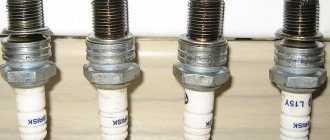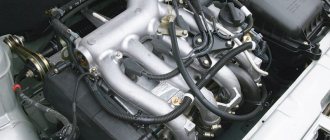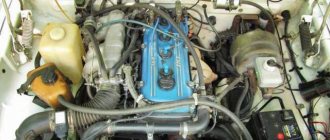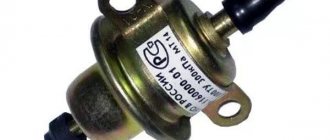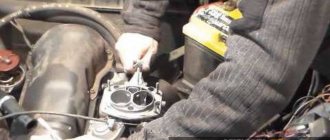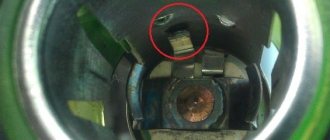Doesn't Start When Hot - TOP 3 Causes of Poor Engine Starting
With the arrival of hot days, more and more drivers are faced with the problem of poor engine starting when hot, after several minutes of parking. Moreover, this is a problem not only for carburetor engines - a situation where it does not start when hot can await both owners of cars with injection engines and diesel cars. Only the reasons are different for everyone. Here we will try to collect them and identify the most common ones.
When a hot carburetor engine does not start
Why is it difficult to start when hot and what to do?
the volatility of gasoline is mainly . The bottom line is that when the engine warms up to operating temperature, the carburetor also heats up, and after turning it off, within 10-15 minutes, the fuel begins to evaporate, making it difficult to start the car.
Installing a textolite spacer can help here, but it does not give 100% results.
In such a situation, pressing the gas pedal to the floor and purging the fuel system will help to start a hot engine, but not longer than 10-15 seconds, since fuel can flood the spark plugs. If the question concerns the Zhiguli, then the fuel pump may also be to blame, since Zhiguli gasoline pumps really do not like heat and sometimes completely refuse to work when overheated.
When an injection engine does not start
Since an injection engine is somewhat more complex than a carburetor engine, there will be more reasons why such an engine will not start. In particular, they may be malfunctions of the following components and mechanisms:
- Coolant temperature sensor. In hot weather, it may fail and supply incorrect information to the ECU, in particular, that the coolant temperature is higher than normal.
- Crankshaft position sensor (CPS). Its failure will lead to incorrect operation of the ECU, which in turn will not allow the engine to start.
- Mass air flow sensor (MAF). In hot weather, the sensor may not cope with the tasks assigned to it, since the temperature difference between the incoming and outgoing air masses will be insignificant. In addition, there is always the possibility of its partial or complete failure.
- Fuel injectors. Here the situation is similar with a carburetor engine. The fine fraction of gasoline evaporates at high temperatures, forming an enriched fuel mixture. Accordingly, the engine cannot start normally.
- Fuel pump. In particular, it is necessary to check the operation of its check valve.
- Idle air control (IAC).
- Fuel pressure control.
- Ignition module.
Next, let's move on to considering the possible reasons for poor hot starting in cars with diesel engines.
When a hot diesel engine has trouble starting
Unfortunately, diesel engines can also sometimes fail to start when hot. Most often, the causes of this phenomenon are malfunctions of the following components:
- Coolant sensor. Here the situation is similar to that described in the previous section. The sensor may fail and, accordingly, transmit incorrect information to the ECU.
- Crankshaft position sensor. The situation is similar to an injection engine.
- Mass air flow sensor. Likewise.
- High pressure fuel pump. In particular, this can happen due to significant wear of the bushings and oil seal of the pump drive shaft. Air enters the pump from under the seal, making it impossible to build up operating pressure in the pre-plunger chamber.
- Diesel engine idle system.
- Fuel pressure control.
- Ignition module.
Now we will try to summarize the information provided so that it is easier for you to find the cause of the breakdown if it happens to your car.
DTOZH
fuel injectors
injection pump plunger pair
Three main reasons for poor hot starting
So, according to statistics, the main reasons for poor engine starting after idle time at high temperatures are:
- An enriched fuel mixture, which is formed due to low-quality gasoline (its light fractions evaporate, and a kind of “gasoline fog” is obtained).
- Faulty coolant sensor. At high ambient temperatures, there is a possibility of its incorrect operation.
- Faulty ignition. It may be incorrectly set or there may be problems with the ignition switch.
We will also provide you with a table where we tried to visually show which components can cause problems, and what needs to be checked in different types of engines.
Types of engines and their characteristic causesCarburetorInjectionDiesel
| Poor quality fuel, evaporation of its light fractions |
| Faulty coolant sensor |
| Crankshaft position sensor |
| Mass air flow sensor |
| Fuel injectors |
| Fuel pump |
| High pressure fuel pump |
| Idle speed control |
| Fuel pressure control |
| Diesel idle system |
| Ignition module |
Why does a warm engine stall?
Some motorists are faced with a situation where an already running and warmed-up engine suddenly stalls. Moreover, this happens after the sensor has recorded a set of normal operating temperatures. There may be several reasons for this. Next, we will consider them in more detail, and also indicate what needs to be done in this or that case.
- Poor quality fuel . This situation is typical, for example, if you are driving away from a gas station, and after a short period of time the engine begins to “cough”, the car jerks and stalls. The solution here is obvious - drain the low-quality fuel, bleed the fuel system and replace the fuel filter. It is also advisable to replace the spark plugs, but if they are new, you can get by by blowing them out. Naturally, you shouldn’t go to such a gas station in the future, but if you have saved your receipt, you can go there and make a claim about the quality of the fuel.
- Fuel filter . If the engine stalls, you should also check the condition of the fuel filter. And if according to the regulations it is already necessary to replace it, then this must be done, regardless of whether it is clogged or not yet.
- Air filter . The situation is similar here. The engine may “choke” on the rich mixture and stall shortly after starting. Check its condition and replace if necessary. By the way, this way you can also reduce fuel consumption.
- Gasoline pump . If it does not operate at full capacity, the engine will not receive enough fuel and, accordingly, will stall after a while.
- Generator . If it completely or partially fails, it stops charging the battery. The driver may not immediately notice this fact, start the engine and drive off. However, it will only drive until the battery is completely discharged. Unfortunately, it will no longer be possible to start the engine on it again. In some cases, you can try to tighten the alternator belt. If this procedure does not help, you need to call a tow truck or call your friends to have your car dragged to a garage or service station.
Main reasons
Kalina has a fairly common reason that it does not start the first time. This is due to design, wear and tear and electrical issues. But, it is worth breaking the problems into categories and considering them in more detail. So, let's look at the main categories into which this malfunction is divided:
- Problem with the fuel system.
- The reason is the ignition.
- Failure of timing elements.
- The problem is in the operation of electrical circuits and the ECU.
When everything is sorted out into the causes, it is worth considering them in more detail and how to eliminate them on the car.
Fuel system
The first reason that a car may not start the first time is the fuel system. Insufficient fuel or too much gasoline becomes a problem.
A failure of the fuel pump or a clogged fuel filter can cause the pressure in the fuel line to be insufficient and the mixture to be lean. Accordingly, the small amount of fuel in the combustion chambers is not enough to start the engine. If too much fuel mixture is supplied, the spark plugs are simply thrown and there is no spark to ignite, which causes the engine to not start.
Ignition
The second reason for poor starting is a malfunction of the ignition system. The problem may lie in the following nodes:
- Ignition switch malfunction.
- Breakdown in high-voltage wires.
- Spark plugs are worn out or dirty.
When considering the problem, it is necessary, first of all, to pay attention to the spark plugs, clean them and adjust the gaps using a feeler gauge. Next, you need to check the ignition wires, resistance and insulation damage
If necessary, it is worth replacing failed products.
Gas distribution mechanism
You can often find in manuals that starting not the first time is associated with incorrect operation of the gas distribution mechanism. First of all, this is due to carbon deposits that form on the valves, as well as incorrect operation of the gas distribution phases. The malfunction should be looked for in the camshafts, as well as the position of the crankshaft relative to the camshaft.
Another reason could be wear on the timing belt and pulley. A stretched belt can disrupt valve timing. It is worth checking and, if necessary, installing a new timing belt repair kit.
Electrics
The last reason why such a malfunction may occur is electrical parts and circuits. So, the problem may lie in the starter, electronic control unit or wiring. We discard the main cause of the battery, because if it is dead, then the car will not start the second time. Let's consider all the reasons separately.
Starter
Problems in the operation and failure of the elements of this unit can cause a poor start. So, failure of the solenoid relay or bendix may cause the Lacetti to not start the first time. Also, it is worth checking the wires, which can oxidize and skip contacts every once in a while.
Wiring
Breakdowns and problems in the wiring can cause the car to not start the first time. So, you should look for a problem between the battery terminals and the starter, as well as the ignition coil and spark plugs.
ECU
The electronic control unit can be the main reason why the car does not want to start the first time. Thus, a large number of errors can lead to the issuance of incorrect commands. For example, incorrect amount of fuel distributed or mixture enrichment. It’s worth getting into the ECU after the fuel system, ignition and starter have been checked. The cause is eliminated by resetting errors or changing the firmware.
Chevrolet Niva doesn't start well
Every owner of a vehicle experiences situations where you are in a hurry to go to work in the morning, get behind the wheel of your car, and then the unexpected happens - the car does not start. All car owners know what an unpleasant situation this is.
To solve this problem, it is necessary to find out the reason, and what could be the reason in such a car, with a large number of different parts? Even experienced car owners sometimes ask this question. After all, you will never guess which part has failed and how to eliminate this reason.
In order to understand this issue, we will consider all the sources of malfunctions in the Chevrolet Niva, how to identify them correctly, what is necessary to resolve them and why this happened.
To troubleshoot a car problem, you first need to find out the source why the car won’t start. The driver can be helped in identifying damage by various sensors on the instrument panel, an external inspection of the car, or the sound that is made when the key is turned. So, the main problems that cause the engine to start poorly and the car will not start may be the following malfunctions.
Causes of electrical damage:
- The car battery has become unusable or discharged. This basis is primary for all types of cars.
- The starter became unusable due to getting wet, or, as they say, it served its purpose.
- Poor contact from the battery due to oxidation of the terminals.
- Defective spark plugs, which could occur in the following cases:
- Poor quality fuel, which led to them getting wet.
- The spark plugs have already worn out and a large gap has formed.
- The fuse has blown.
- The ignition relay or something else has failed.
- The wire supplying the main components of the car (for example, power supply to the starter or injector) has come off.
- The immobilizer does not work.
If for any reason the anti-theft system does not work, the car will not be able to start until the immobilizer malfunction problem is resolved.
Mechanical faults:
- There is no fuel in the gas tank. This may not only be the fault of the driver, because there is a possibility of a breakdown of the fuel level sensor. Not every driver counts fuel by the number of kilometers driven.
- Clogging of the fuel filter or fuel pump, which leads to breakdown of the latter.
- Nozzle clogged.
- Insufficient oil level in the engine or antifreeze in the radiator. Causes the engine to overheat.
- The idle speed control is damaged.
How to find out the cause of the problem
Knowing the most common sources for which the Chevrolet Niva does not start well, now you need to find out how to correctly determine the damage? After all, there are many reasons, and it will take a considerable amount of time to check all this. Finding out the reason why your iron horse does not want to work is done with the help of your eyes, ears and car tips.
You can call a technician to your home, who will determine the damage in a matter of minutes, and sometimes even seconds. And for this clarification, you will have to pay a lot of money. You can take your car to a service station by asking a friend to help with transportation. It will cost much less than calling a technician to your home, but you will spend a lot of time. Therefore, your best bet for determining damage is you and your head.
Only if all possible reasons have been verified, then it is necessary to contact a specialist. Perhaps your car requires a major check of the entire system.
Knowing all the shortcomings why the Niva does not respond to turning the key in the ignition, you can easily identify them:
- You can determine whether the battery is damaged by checking the presence of power in the car when you turn the key. If at this moment the entire panel, as they say, is silent, then you need to charge the battery or replace it with a new one. Recharging may take a couple of hours if the battery is in good condition, but if the electrolyte density is low, then you only need to purchase a new battery.
- We can talk about failure of the starter to perform its function if it is definitely determined that the battery is in good working order. It is possible that when you turn the key, the starter will click but will not start. In this case, this also indicates that the battery does not provide the current necessary to start the engine. To find out 100% the cause of the starter, you can connect a voltmeter and ammeter to its terminals and measure the current and voltage, respectively.
- Damage to the contacts on the battery can be detected by opening the hood and visually assessing their oxidation. Often, drivers simply do not notice oxidation due to the rubber lining on the terminals.
- Spark plugs can be checked by unscrewing them from the cylinder block and performing a visual inspection. They should not be wet, and black carbon deposits indicate their damage. The normal color of candles should be dark brown.
- The fuses can be checked by removing the cover and visually inspecting them. If a fuse is blown, it will be visible and will most likely be completely melted. You can also ring each of them using a tester.
- Damage to the ignition relay can be determined visually; if there is no reaction when turning the key, the relay should be replaced. You can check it by installing a working relay.
- You can determine the lack of contact on the main components of car parts by visual inspection. It is necessary to tighten the contacts on the starter, the injector power supply and the fuel pump. The positive wire that powers the electronic injection system comes directly from the battery terminal with a separate wire.
- Often the problem with the immobilizer can be a low battery. You just need to install a new battery.
This is to find out the reasons for the malfunction of the electrical part of the car, but do not forget about mechanical damage:
- The indicator on the instrument panel will help you find out if there is no fuel in the tank. If the fuel gauge is at zero and the warning light in the form of a gas pump is on, then the source of the trouble has been detected and there is no need to open the hood.
- You can determine if a filter or fuel pump is faulty by hearing. If you hear a strong buzzing sound (in the rear trunk area), then most likely the filter or pump is clogged, which is not delivering fuel to the engine.
- A clogged injector can be seen on the instrument panel; the red “CHEK ENGINE” indicator lamp should light up. It indicates any damage to the injector or engine error.
- If the oil level in the car has dropped, this can be determined visually using a warning lamp in the form of a can on the instrument panel. If you are sure that there is enough oil in the engine, pull out the level meter and check.
Trouble-shooting
Having identified the problem that causes the Chevrolet Niva engine to start poorly, you can begin to fix the problem. Knowing the source of the problem, you can draw the appropriate conclusions: are you able to fix the error yourself, without requiring additional help? Most of the above reasons are of a simple nature of damage, and correcting them will not take much time. For the convenience of solving the problem that causes the Shevik to not start, information on how to eliminate them is recorded in tabular form in Table No. 1.
Table No. 1. A list of the main malfunctions when the engine does not start or starts poorly, and how to eliminate them.
| Malfunction | Remedy |
| battery | Replace or recharge the battery. You can light a cigarette from another car, then the generator will recharge the battery. Clean the contacts if they are oxidized and lubricate them with Litol. The lubricant prevents the appearance of oxide on the terminals. Tighten the terminals well to get good contact. |
| Starter | Check the starter contacts and tighten them. In the event of a malfunction, have the starter repaired to rewind the windings or install a new one. |
| Spark plug | Replace all 4 spark plugs with new ones, or clean them with sandpaper. But in any case, if the spark plugs have worked out, they need to be changed so that there are no problems with the engine. Refuel only at branded gas stations, and only with fuel that is suitable for this type of engine (A-95). |
| Fuses | Install new fuses. It is better to visit an auto electrician to determine the root cause of the failure of the fuses. |
| Ignition relay | Replace with a new relay. |
| Broken wires of main components | Having found out which wire is broken, you need to find out the reason why this happened. After that, install it in place. |
| Immobilizer | The anti-theft system suffers from battery failure. Wire breaks rarely occur. It is necessary to replace the battery with a new one, preferably a high-quality one. |
| Lack of fuel | Pour quality fuel into the tank and wait until the fuel pump pumps it into the engine. |
| Clogged fuel filter and fuel pump | Replace the gas filter with a new one. Remove the fuel pump and clean it. |
| Lack of oil or antifreeze | Add oil to the engine and find out the reason for its disappearance. The gasket through which the oil escapes may be damaged. Add antifreeze to the expansion tank and check for fluid leaks. |
Drivers often encounter the problem of poor engine starting in winter, during periods of severe frost. These frosts damage not only the battery, but also all parts where water may have entered. This problem is also often encountered in extreme heat, when the engine overheats and then has difficulty starting.
Now knowing why the Chevrolet Niva may not start, you can easily go looking for a problem. Having identified the breakdown, you will solve the problem of poor engine starting by 50%. And the solutions are now known, so you can hit the road.
Source: https://chnivaremont.ru/dvigatel/ploxo-zavoditsya-niva-chevrole.html
Fuel pump problem
The fuel pump in a car does not have special cooling. It is located in the tank and is cooled by gasoline, and if there is little gasoline in the tank, the pump may overheat. Therefore, it is not recommended to drive while the “Refueling” light is on. Also, in hot weather, the gasoline in the tank heats up, as does the fuel pump during operation. All together, this leads to the fact that during the process of pumping gasoline, the pump gets very hot and refuses to start until it cools down. In this case, the pump may refuse to work even while driving: it simply stalls. If the engine does not start well when hot due to the pump, then the experts recommend:
- Replace it. This is a simple and correct solution. The cost of the pump is small - about 1000 rubles. You will also have to pay 500 rubles to replace it.
- Allow the pump to cool and try to start the engine again.
Chevrolet Niva won't start: reasons, how to fix it - AutoExpert
It happens that the starter works fine, but the engine stubbornly refuses to start, although the Check lamp does not light up. In such cases, if we talk about the VAZ-2123 engine, we can immediately name 10 different reasons.
All of them will be quite real, and not at all from the category of “contacts have oxidized.” In general, sometimes the Chevrolet Niva does not start, but the starter turns the shaft properly, and the reason should not be looked for there.
Well, let's try to learn to recognize different reasons, that is, to distinguish one from the other.
Example in the video: the APS immobilizer blocked the engine because it was in learning mode!
Chevrolet Niva does not start: three different sensors
The crankshaft position sensor will not indicate its failure in any way. The Check light will not light up, the engine will simply not start. Finding this sensor is easy if you know where the alternator belt is (see photo).
DPKV sensor connector
Here we check the serviceability of the wiring, as well as the distance from the sensor to the “teeth” (0.8-1.2 mm).
The second suspicious element will be the temperature sensor. The engine may not start only if it breaks. In this case, the electric fan should work without turning off. That is, a break in the DTOZH sensor circuit is easily recognized.
Element “6” is DTOZH
In the photo there is a sensor, and to get to it, the air duct is removed.
If the idle speed control malfunctions, the engine on a Chevrolet Niva does not start, but the starter turns. By the way, the Check lamp may be on. Diagnostics:
- Just lightly press the gas and turn on the starter;
- If the engine starts, but without gas it does not start, it means the IAC is faulty.
Set of "electrical" reasons
The first step in diagnostics: remove the cap from any spark plug, install spark plug A17DVRM and, holding it with pliers, turn on the starter.
How to remove the cap
The spark plug must be held by the hexagon, the pliers must have insulated handles, and the spark plug body must touch the “ground”. As a result, a spark can be observed. If there is no spark, it means:
- The ECM is faulty or is not receiving voltage;
- The ignition coil module burned out;
- High voltage wires are faulty.
The drawing for point “1” is given below.
Power supply point to the ECM
The presence of a spark “in the air” does not guarantee its presence in the engine. The spark plugs may be faulty, the gap may be incorrect, etc.
The number of reasons why the Chevrolet Niva does not start, but the starter turns, has increased to 7.
Immobilizer blocks engine starting
If the immobilizer has been activated, then sooner or later it will block the engine from starting. It happens like this: when you turn on the ignition, the indicator flashes for 15 seconds, then goes out. And then the system produces sound signals.
“2” – immobilizer lamp
The APS-4 module can be disabled. For this you need a “red” training key. Well, the APS-6 unit cannot be turned off. Usually you have to flash the ECM.
There is no need to panic right away: perhaps the blocking occurs due to irregularities in the “reader” wiring.
Fuel rail
On the ramp next to regulator 5 there is a control fitting 3. It is closed with a cap, which is unscrewed and then carefully pressed on the spool.
Ramp drawing
If fuel flows, it means it is entering the ramp. But perhaps the necessary pressure is not created. Reasons: clogged filter cylinder, pump malfunction, etc.
https://www.youtube.com/watch?v=NQy_mOVq0h0
The pressure should be 350 kPa (3.5 bar). It is controlled by unscrewing the spool and installing a pressure gauge. Before checking, you need to reduce the pressure!
If fuel does not flow, notice whether the pump turns on when the key is turned to the “I” mark. When the ignition is turned on “cold”, the pump should run for 10 seconds.
Additional mounting block
Know that fuse F2 and relay P4 are responsible for turning on the pump. There is also a main relay P5, and all these elements are located in a block mounted on the same bracket with the ECM (see photo).
Even if the pressure is normal, the injectors may be clogged. In addition, their wiring may be damaged.
Case from practice
What happens if water gets into gasoline? In the summer - nothing. And in winter, the power supply system can become clogged with ice. All elements are at risk, from the pump to the injector valves!
Fuel supply line filter
A small amount of water is always present in fuel. If this number is increased, this is what happens:
- The first start always goes without problems;
- Then, after leaving the car in the parking lot, after 2-3 hours the owner will no longer be able to start the engine without repairs.
All of the above applies to any injection internal combustion engine, including the VAZ-2123. And the “first candidate for failure” will be the fuel filter. It is located under the bottom of the Chevrolet Niva and is encased in aluminum (see photo). However, this is done on many cars.
Pumping up excess air
One smart book says that the engine may not start due to the fact that the intake manifold draws in too much air. This means you need to check the fastening of all pipes. But not only.
Vacuum brake booster
The source of “excess air” may be a faulty VUT. The starter turns, the engine on the Chevrolet Niva does not start, and the reason, it turns out, must be sought in the brake system!
We won't look for anything. Let's do it simpler:
- The vacuum supply hose is removed from the amplifier side (see drawing);
- The hole in the hose is closed with a finger and one test run is performed;
- The engine starts, which means the cause has been found.
That's the whole trick. We wish you success!
Despite its apparent simplicity, defects in the air supply system are difficult to detect. Check the fit of the hoses on the fittings and the tightness of all clamps.
Chevrolet Niva won't start, we look for and eliminate the reasons
Malfunctions of the electrical part First of all, for all types and models of cars, you should pay attention to the battery - it may be worn out or the Chevrolet Niva may simply not start. Finding out the reasons in the mechanical part So, next you need to check the fuel pump and filter. When you turn the key, you can diagnose battery problems.
Manuals → Chevrolet → Niva (Chevrolet Niva). The engine will not start. Problems starting a car engine...
In the event of a malfunction, have the starter repaired to rewind the windings or install a new one. The fuses can be checked by removing the cover and visually inspecting them. Next, we check the injection time and ignition timing when scrolling.
But perhaps the necessary pressure is not created. Dark brown is a normal candle color. Try to set fire to the merged substance, or just smell it.
The reason is a violation of contact connections, a break or short circuit in the starter switching circuits, a malfunction of the traction relay. When the starter is turned on, multiple clicks are heard. The reason is a malfunction of the holding winding of the traction relay, the battery is severely discharged, and the contact connections in the starter circuit are loose.
The starter turns on, but its armature either does not rotate or rotates slowly. Case from practice What happens if water gets into gasoline?
And in winter, the power supply system can become clogged with ice. All elements are at risk, from the pump to the injector valves! Fuel supply line filter There is always a small amount of water in the fuel.
If this number is increased, this is what will happen: The first start always goes without problems; Then, after leaving the car in the parking lot, after an hour the owner will no longer be able to start the engine without repairs.
Electrical faults
To do this, they need to be unscrewed and inspected. They should be dry and free of black soot. They can also be inspected. If any of them are melted or cracked, their service life has passed.
Sometimes the ignition relay fails. If absolutely nothing happens when you turn the key, most likely this particular element has failed. If the car does not start due to the immobilizer, apparently the battery in the key fob is simply dead.
Finding out the reasons in the mechanical part So, next you need to check the fuel pump and filter. If when you turn the key you hear a buzzing sound in the area of the rear seat and luggage compartment, these are the elements that are faulty. In principle, nothing complicated. Once the fault has already been found, getting rid of it is quite simple.
Almost any of the above reasons can be easily eliminated.
In other words, if you are looking for the reason why the engine refuses to start, you need to start not with replacing the fuel filter or checking the DPKV connector, but with something completely different.
Let's bring final clarity to this issue. What does an engine need to work? Only I would add: All defects will ultimately result in these two.
To do this, it is not enough to simply unscrew the spark plug and, connecting it to a high-voltage wire and placing it on ground, crank the engine.
The gap on the spark plug is such that at atmospheric pressure, breakdown will occur even with a half-dead ignition coil. And it is impossible to assess the quality of sparking by eye.
Problem with DPKV
Another common element that affects hot starting of the engine is the crankshaft position sensor (CPS). Quite often it refuses to work when the engine temperature rises. This is one of the elements without which the operation of the entire system is generally impossible. After replacing the DPKV, everything returns to normal for many car owners. Therefore, when your VAZ car has difficulty starting when hot, it makes sense to try replacing this sensor. It costs a penny (a new one is around 500-600 rubles, although you can look for a used one). You can even make the replacement yourself, you just need to know where it is and have screwdrivers on hand. Finding out its location on each car is not a problem - all the information is on the Internet.
Reasons why the starter on a VAZ 2106 does not turn
Battery and terminal contact
- The battery is dead . Of course, experienced drivers will immediately understand when the battery is low, but some beginners may not understand that the reason is precisely the battery being low. Simply turn on the low beam and see how bright the lamps are. Usually, if the battery is low enough, the lamps may glow dimly or not light up at all. In this case, it is necessary to charge the battery.
- Poor contact of battery terminals . It also happens that all the instruments and lights on the instrument panel seem to be lit, electrical appliances are working, but the starter does not turn. If the contact at one of the terminals is poor, then there may not be enough current to crank the starter. To avoid this, it is necessary to lubricate the terminals with thick lubricant after each removal and installation of the battery. For example, like litol, and then such a problem will not arise!
Ignition switch, relay
- The ignition switch is faulty . I think that some owners of the VAZ 2106 had to deal with such a problem, when it was precisely because of the ignition switch that the starter did not turn. That is, you turn the key to the start position, but no reaction occurs. To test this theory, it is enough to bridge the necessary wires going to the lock, and if the starter works, then that is the reason. In this case, it will be necessary to replace the ignition switch.
- Solenoid relay malfunction . Usually, with such a problem, when you try to start the engine, either nothing happens at all or you hear clicking sounds. But the starter shaft itself does not spin! You can check the retractor as follows. It is necessary to close the two contacts with the nuts on the starter; if it works, replace the solenoid relay.
- Worn brushes, broken chain in the armature winding . In this case, you will not hear any signs of life in the device when you try to start the engine. And to figure out what exactly is the reason, a complete disassembly of the mechanism and its diagnostics will help.
I gave examples of malfunctions from personal experience in operating a VAZ 2106 and other domestically produced cars. Of course, I do not exclude the possibility that there are other reasons for such problems. If you have anything to share or have any questions, you can ask them below in the comments. We will discuss and try to solve the problem together. Thank you for your attention.
Problems of domestic cars
Many domestically produced cars also have trouble starting when the engine is hot. The problem is in the design, but this time the gas tank. The fuel pump, which heats up during operation, should, in theory, cool down a little during operation. This occurs due to the liquid that moves through its body. During the summer heat, the liquid heats up, so cooling does not occur, which leads to disastrous consequences.
A faulty high-pressure fuel pump (HPF) stops working, which leads to a disruption in the fuel supply to the engine. Subsequent turns of the key and pushes will not help, but there are several “old-fashioned” methods. The device needs to cool down.
- Wet a cloth in cold water and apply it to the fuel pump housing until it cools down.
- Roll the car to a cool, sheltered place from the sun, open the hood. Wait a while for the unit to cool down. This usually takes 15–20 minutes.
An overheated fuel pump breaks down completely and cooling will not help it, so if after some time the car still does not start, you will have to replace the part. If the engine still starts when cold, then the problem is in the turbocharger.
It is recommended to replace the device, otherwise the problem will recur every few days.
A warm engine may not start due to poor quality fuel or the presence of unacceptable additives. This happens after changing the fuel. At the first start, everything may be in order, but then the engine stalls and does not want to start.
Checking this option is quite simple - cool the car. If you subsequently start it cold and hear extraneous sounds from the engine, most likely the problem is in the fuel. The engine does not start for other reasons:
- The presence of components in the fuel that do not allow the creation of a combustible mixture. In different cases the effect may be different, sometimes there is not enough spark to ignite, sometimes more air is required for ignition. Small inclusions also prevent the engine from starting.
- The fuel filter is clogged, which is why the pump cannot supply fuel. In such cases, thick smoke comes from the gas outlet. You need to remove the filter, clean it and put it back.
Problem starting on gas
HBO has settled under the hoods of many cars. This system allows you to save a lot, but at the same time it is quite capricious. If your engine runs on gas, and after a short period of inactivity there are problems with starting, then it is better to contact a service station. The reasons why the engine is difficult to start when hot can be different. We cannot exclude a situation where the expansion of gas in the tank created additional pressure, causing the ratio of gas and air mixture to change. This may be the reason for poor engine starting when hot. The same crankshaft position sensor also cannot be ruled out. It may not work well regardless of whether the engine is running on gas or gasoline.
Common reasons why the idle stalls:
1. The most common one is the idle speed regulator (sensor), which is directly related to engine idle speed. It’s quite easy to check whether there is a breakdown. If the car does not start when you turn the starter, operate the gas pedal, the engine should start. If the revs start to fluctuate immediately after you take your foot off the pedal, there is a 99% chance that the reason is in the idle speed control. The solution is to replace the idle air control; this will take VAZ owners a minimum of time.
2. The second probable reason why the engine stalls at idle is problems with the throttle valve. This problem can be cured by simply cleaning the throttle valve.
3. If after cleaning the problem persists, we assume that the reason why the engine stalls at idle may be the TPS (throttle position sensor). The problem is solved by replacing the TPS; the procedure is not complicated and can actually be done with your own hands.
There are often cases when the engine stalls while driving, as they say, out of the blue. The most probable and most common reasons why this may happen will be listed below.
The engine stops while running - reasons
1. Poor quality fuel is the first thing that comes to mind for most of us, and besides, this is where we need to start looking for the reason for the engine stopping while driving. You will be “lucky” if this happens immediately after refueling, in which case you can confidently say that the problem is in the fuel. Treated by draining the fuel and replacing the fuel filter.
2. Candles. As a rule, suspicion most often falls on them, after bad fuel, of course. Everything is simple here - unscrew the spark plugs and check their condition, replace the spark plugs if necessary.
3. Fuel filter. A seriously clogged filter can cause an interruption in fuel supply, causing you to rev the gas and the engine to stall while driving. To eliminate the problem, simply replace the fuel filter.
4. Air filter. Everything is the same as with the fuel, if it is clogged, then no air comes in, therefore the fuel-air mixture comes out over-enriched and the spark plugs simply flood. In addition, due to lack of air, the engine will choke, that is, the power will drop, and the combustion process of the mixture in the cylinders will not be able to take place, and eventually the engine will stall. To eliminate this problem, simply replace the air filter.

